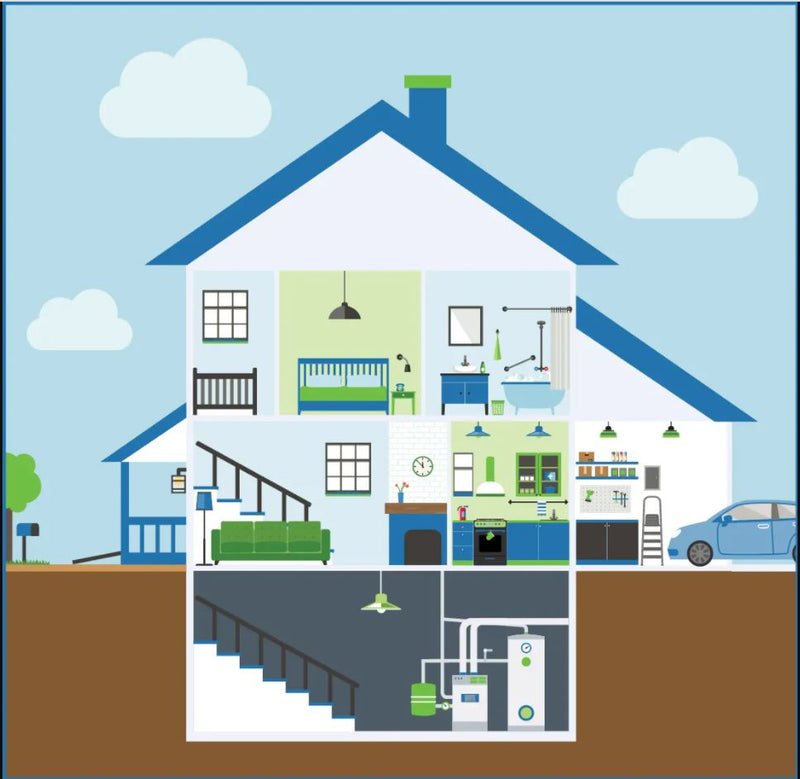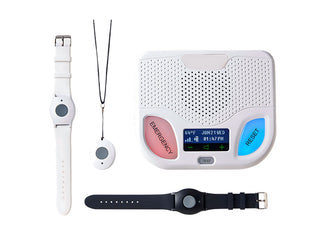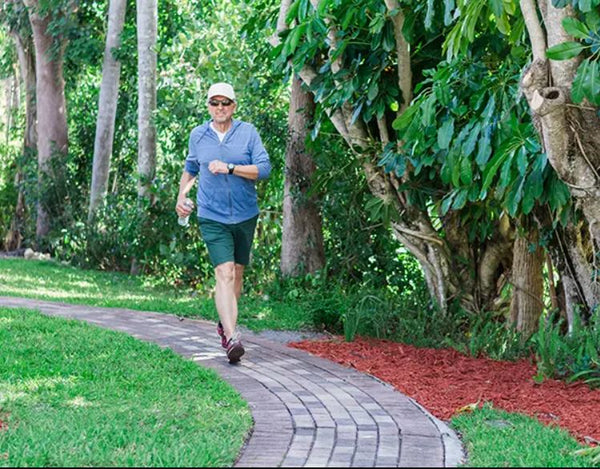Health Updates
Complete Safety Guide for Caregivers

Most seniors prefer to live at home as long as possible, so having a caregiver to help with the responsibilities will not only take the burden off of their shoulders, but also make them more confident in living independently.
As a caregiver, it’s important to foster a safe and comfortable environment, but it’s easy to overlook some of the potential dangers associated with independent living. According to the National Council on Aging (NCOA), an older adult is treated in the emergency room every 11 seconds for a fall. To help prepare a senior’s home for safe living and avoid falls, use our room-by-room guide with safety tips and advice.
For the times that you aren’t in the home, we suggest providing a medical alert system that they can wear and use anytime they need emergency assistance.
Home Safety Advice for Caregivers
As a caregiver for an older adult, your number one priority is their safety while living comfortably at home. To reduce the risks involved with living independently such as falls or fires, it’s important to review each room in the house for potential hazards.
Around the Home
HVAC and plumbing: Check to see if the heating, cooling and plumbing are working properly every season. Call an expert if there are any repairs that need to be completed.
Electrical safety: Improper management of electrical items can create fire and shock hazards. To combat these hazards, don’t run cords under furniture/rugs and don’t hang them with nails or staples. Also, make sure that proper light bulbs are being used and that all cords are in good condition. A professional electrician can inspect the home as well to double check everything.
Pest control: Ensure that there is an absence of bugs and rodents inside the house. Call a pest control expert as needed.
Properly label and store items: Properly label and store chemicals, flammables and other hazardous items. If it is something flammable, keep it away from any heat sources.
Lighting: Falls and accidents can be avoidable with the right lighting. Check to see if all rooms and hallways have sufficient lighting on a regular basis.
Organize walkways: According to the US National Library of Medicine, an estimated 37,991 adults over the age of 65 were treated for fall injuries associated with carpets and rugs annually. To avoid any falls in the home, properly place and secure all slip-resistant carpets and rugs. It also helps to get rid of any obstacles that are in heavy traffic walkways and to use non-slippery wax to treat floors.
Stairway safety: Reduce falling hazards with stairways that are well-lit, clear and have a non-skid surface. Stairways should also have a solid handrail and if possible, light switches at the top and bottom.
Emergency precautions: Make sure there is a first aid kit, fire extinguisher, smoke detectors and carbon monoxide detectors in the house! Post any important numbers near the phones for nonemergencies and remind them to wear a medical alert system for any unexpected emergencies.
Kitchen
Adequate storage: Store all items in the kitchen for easy retrieval and to decrease fire risks. Place heavier items in lower cabinets and lighter items in higher cabinets. Frequently used items such as oven mitts are best when within an easy reach. Also, store sharp knives in a rack to avoid cuts.
Fire safety: Kitchens are most susceptible to fires – keep a fire extinguisher handy and make sure everyone in the home knows how to use it properly. It can also help to clearly mark stove dials to indicate whether the range is on or off.
Proper lighting and ventilation: Install proper lighting in the kitchen for easy navigation and visibility. There should also be proper ventilation in the form of windows or a vent system to rid of any indoor air pollutants while cooking.
Food safety: We’ve all found a few expired cans in our cabinet! Help check for expired foods on a regular basis.
Electrical safety: Check to see if the cords of extensions and appliances are away from the sink and range.
Bathroom
Water temperature: Set the water heater to 120 degrees fahrenheit or lower to reduce the risk of scalding hot water in the shower. It’s also important to clearly mark faucets hot and cold to avoid any confusion.
Bath accessories: According to NewsUSA and the National Institute on Aging (NIA), 80 percent of senior falls are in the bathroom. Grab bars, non-slip shower mats and bath seats can reduce the chances of falling in the shower or bath.
Lights: Ensure the door lock has a release on the outside. If a senior falls down in the bathroom and can’t get up, someone will help the responder reach them quicker.
Emergency lock: Ensure the door lock has a release on the outside. If a senior falls down in the bathroom and can’t get up, someone will help the responder reach them quicker.
Toiletries: Make sure there is soap, proper disposal of soiled pads and an electric razor for those with shaky hands.
Electrical safety: Small appliances can be a hazard if plugged in all the time. Remind them to unplug small appliances if they are not in use.
Living Room
Furniture: Arranging sturdy furniture properly can reduce the risk of tripping and falling. Furniture should be placed so lamps and appliances are next to outlets and have clear walkways around the living room.
Chimney: The chimney is a fire hazard if not cleaned and cleared of leaves and debris. By keeping the chimney clean and clear, you’ll eliminate the chance of chimney fires and poisonous fumes in the house.
Bedroom
Lighting: There should be a light switch next to the bedroom entry and a lamp switch next to the bed. Night lights around the room will increase visibility at night when going to the bathroom.
Bed adjustments: Beds should be adjusted that so the height is perfect for getting out. Bed rails can be added as needed.
Bedside items: On the side of the bed, make sure they have access to a phone, list of emergency numbers, flashlight, and an emergency alert system. Also. make sure that ashtrays, smoking devices, and fire sources are away from the bed.
Garage
General: Keep the floor clean of debris and obstacles to decrease tripping hazards. The garage should be well-ventilated, well-lit and have a light switch near the entry. Keeping a sturdy ladder or stool with railings will help reach items in high places.
Power tools and equipment: Power tools and equipment are good to have around the home for quick fixes, but can be dangerous if not kept in good condition or stored properly. Put heavier items on lower shelves and lighter items on higher ones.
Chemicals, liquids and gas: Chemicals, liquids and gas have a chance of poisoning or creating a fire if handled irresponsibly. Properly identify chemicals so they aren’t mistaken for anything else. Tightly cap any volatile liquids and store propane tanks outside.
Electrical safety: Make sure to use the correct size fuses for the circuit box. It’s also important to test the circuit breakers that lead to your garage by flipping them on and off every few months.
Exterior
Entry and exit safety: Proper lighting near the front and back door illuminates steps and reduces tripping hazards. There should be a solid rail for stairs, good traction floor and a low threshold for doorways. If necessary, a ramp can be installed for easy entry and exit.
Clear path: Ensure there is a clear path from the front door to the mailbox, free of clutter, snow or leaves.
Visibility: The home should be easily visible for emergency responders in the case of an emergency. Illuminate the house number at night and check to see if it’s clearly visible from the street.
Promote Independent Living
Most seniors prefer to avoid going to a nursing home for as long as possible, so helping them with daily tasks will make them feel confident when living independently. Along with ensuring a safe home, there are few checklist items that will guarantee a comfortable living environment.
Medication Safety:
Make sure medications are stored in a secure cabinet and kept in their properly labeled original containers to avoid any confusion and mishaps. It’s also important to check the expiration of medications and make a list of how to take them as prescribed.
Pet Wellness
Pets are known to reduce stress and increase physical activity for seniors! To help care for their pet, put the food in a container with a lid in a convenient location. It can also help to install a pet door with a bell to keep the pet owner aware of when they’re in or out.
Important Documents
It is crucial that important documents are organized, in a central location and have copies. Important documents include birth certificate, list of usernames and passwords, marriage or divorce papers, estate planning documents, health care documents and financial documents.
Transportation
Since many older adults are no longer able to drive and public transportation is not always available, make sure they have a way to get out and go to the grocery store, local clubs or any other errands they might need to make. If you’re providing the transportation, check to see if there are other caregivers in the area and switch off driving a group of seniors to the store.
Highlight a Healthy Lifestyle
Eating a balanced diet and exercising regularly is the key to good health! This especially true for seniors. Encourage your senior to create a schedule with activities and healthy meal ideas to stay on track.
Balanced Diet
Seniors need a high-fiber and protein-rich foods on a daily basis. Encourage them refer to ChooseMyPlate.gov’snutrition guide as an example of the foods they should be eating on a daily basis. It’s common for seniors to revert to frozen foods since they're easier to prepare, but you can make it easier for them by cutting up their produce or meal prepping for the week.
Regular Exercise:
If you’re 65 years of age or older, the Centers for Disease Control and Prevention (CDC) recommends getting at least 150 minutes of moderate-intensity aerobic activity per week. Encourage the senior you’re caring for to engage in activity that they’re comfortable with. This can be anything from walking, gardening and swimming, to chair yoga or small arm exercises with weights or even a water bottle.
With these tips in mind, your senior will feel comfortable with their living environment! To make sure you feel even more confident in their independence, make sure they have a MobileHelp medical alert system that will alert medical help when they’re in need.
Sources:
- National Center for Biotechnology Information - Slipping and tripping: fall injuries in adults associated with rugs and carpets
- NewsUSA - Preventing Senior Falls Starts in the Bathroom
- National Council on Aging - Falls Prevention Facts
- World Health Organization - Physical Activity and Older Adults
- Centers for Disease Control and Prevention - How much physical activity do older adults need?
- ChooseMyPlate.gov







